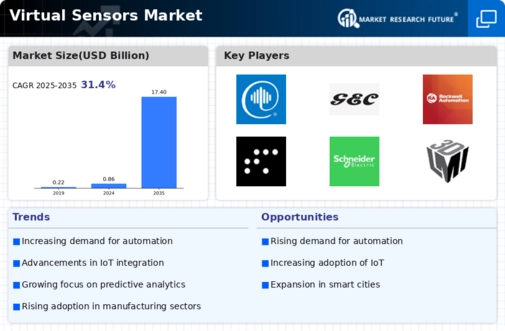-
EXECUTIVE SUMMARY 12
-
MARKET
- GLOBAL VIRTUAL SENSORS MARKET, BY COMPONENT
- GLOBAL VIRTUAL SENSORS MARKET, BY DEPLOYMENT 16
- GLOBAL
-
ATTRACTIVENESS ANALYSIS 14
-
VIRTUAL SENSORS MARKET, BY END USER 17
-
BY REGION 17
-
GLOBAL VIRTUAL SENSORS MARKET,
-
MARKET INTRODUCTION 18
-
DEFINITION 18
-
SCOPE
-
OF THE STUDY 18
-
RESEARCH OBJECTIVE 18
-
MARKET STRUCTURE 19
-
RESEARCH METHODOLOGY 20
-
RESEARCH PROCESS 20
-
PRIMARY RESEARCH 21
-
SECONDARY RESEARCH 22
-
MARKET SIZE ESTIMATION 23
-
FORECAST MODEL 25
-
LIST OF ASSUMPTIONS 25
-
MARKET DYNAMICS 26
-
INTRODUCTION
-
DRIVERS 27
-
SYSTEMS 28
-
INDUSTRY 28
-
AND BENEFITS OF VIRTUAL SENSORS 29
-
INCREASED ADOPTION OF PREDICTIVE MAINTENANCE
-
GROWING DEMAND FOR CLOUD-BASED AND IOT DRIVEN INDUSTRIAL SOLUTIONS
-
RESTRAINT 28
-
SECURITY ISSUES WITH CLOUD-BASED SENSING
-
OPPORTUNITY 28
-
APPLICATIONS OF VIRTUAL SENSORS IN THE AEROSPACE
-
CHALLENGES 29
-
LACK OF AWARENESS REGARDING APPLICATIONS
-
MARKET FACTOR ANALYSIS 32
-
VALUE CHAIN ANALYSIS 32
-
PORTER’S FIVE FORCES 33
- THREAT
- BARGAINING POWER OF SUPPLIERS 33
- THREAT OF SUBSTITUTES 34
- COMPETITIVE RIVALRY 34
-
OF NEW ENTRANTS 33
-
BARGAINING POWER OF BUYERS 34
-
GLOBAL VIRTUAL
-
SENSORS MARKET, BY END USER 35
-
OVERVIEW 35
-
ELECTRONICS 35
-
AUTOMOTIVE
-
& TRANSPORTATION 35
-
MANUFACTURING & UTILITIES 35
-
HEALTHCARE
-
OIL & GAS 35
-
AEROSPACE & DEFENSE 35
-
OTHERS
-
GLOBAL VIRTUAL SENSORS MARKET, BY COMPONENT 35
-
OVERVIEW
-
SOLUTION 35
-
SERVICES 35
-
GLOBAL VIRTUAL SENSORS MARKET,
-
BY DEPLOYMENT MODE 38
-
OVERVIEW 38
-
CLOUD 38
-
ON-PREMISE
-
GLOBAL VIRTUAL SENSORS MARKET, BY REGION 41
-
OVERVIEW
-
NORTH AMERICA 46
- US 49
- CANADA 51
- MEXICO
-
EUROPE 55
- GERMANY 58
- UK 60
- FRANCE 62
- ITALY
- REST OF EUROPE 64
-
ASIA-PACIFIC 66
- CHINA 69
- INDIA
- JAPAN 73
- REST OF ASIA-PACIFIC 75
-
REST OF
- MIDDLE EAST AND AFRICA 80
- SOUTH AMERICA 82
-
THE WORLD 77
-
COMPETITIVE LANDSCAPE 83
-
COMPETITIVE OVERVIEW 62
-
COMPETITIVE BENCHMARKING 63
-
COMPANY PROFILES 64
-
ALGORITHMICA TECHNOLOGIES GMBH 64
- FINANCIAL OVERVIEW 64
- PRODUCTS/SOLUTIONS/SERVICES
- KEY DEVELOPMENTS 65
- SWOT ANALYSIS 65
- KEY
-
COMPANY OVERVIEW 64
-
OFFERED 65
-
STRATEGIES 66
-
ASPEN TECHNOLOGY INC 67
- COMPANY OVERVIEW 67
- PRODUCTS/SOLUTIONS/SERVICES OFFERED 68
- KEY
- SWOT ANALYSIS 68
- KEY STRATEGIES 69
- COMPANY OVERVIEW 70
- FINANCIAL OVERVIEW 70
- KEY DEVELOPMENTS 71
- KEY STRATEGIES 72
-
FINANCIAL OVERVIEW 67
-
DEVELOPMENTS 68
-
ELLIPTIC LABORATORIES 70
-
PRODUCTS/SOLUTIONS/SERVICES OFFERED 71
-
SWOT ANALYSIS 72
-
GENERAL ELECTRIC COMPANY
- COMPANY OVERVIEW 73
- FINANCIAL OVERVIEW 73
- KEY DEVELOPMENTS 74
- KEY STRATEGIES 75
-
PRODUCTS/SOLUTIONS/SERVICES OFFERED 74
-
SWOT ANALYSIS 75
-
OSISOFT LLC 76
- FINANCIAL OVERVIEW 76
- PRODUCTS/SOLUTIONS/SERVICES
- KEY DEVELOPMENTS 77
- SWOT ANALYSIS 78
- KEY
-
COMPANY OVERVIEW 76
-
OFFERED 77
-
STRATEGIES 78
-
SIEMENS AG 79
- COMPANY OVERVIEW 79
- PRODUCTS/SOLUTIONS/SERVICES OFFERED 80
- KEY
- SWOT ANALYSIS 80
- KEY STRATEGIES 81
- COMPANY OVERVIEW 82
- FINANCIAL OVERVIEW 82
- KEY DEVELOPMENTS 83
-
FINANCIAL OVERVIEW 79
-
DEVELOPMENTS 80
-
ROCKWELL AUTOMATION 82
-
PRODUCTS/SOLUTIONS/SERVICES OFFERED 83
-
KEY STRATEGIES 83
-
ANDATA 84
- COMPANY OVERVIEW 84
- PRODUCTS/ SOLUTIONS/ SERVICES OFFERED 84
- KEY
-
FINANCIAL OVERVIEW 84
-
STRATEGIES 84
-
SMARTUQ LLC 85
- COMPANY OVERVIEW 85
- PRODUCTS/ SOLUTIONS/ SERVICES OFFERED 85
- KEY
-
FINANCIAL OVERVIEW 85
-
STRATEGIES 85
-
TACTILE MOBILITY 86
- COMPANY OVERVIEW 86
- PRODUCTS/ SOLUTIONS/ SERVICES OFFERED 86
- KEY
-
FINANCIAL OVERVIEW 86
-
STRATEGIES 86
-
SCHNEIDER ELECTRIC 76
- COMPANY OVERVIEW 76
- PRODUCTS/SOLUTIONS/SERVICES OFFERED 77
- KEY
- SWOT ANALYSIS 78
- KEY STRATEGIES 78
- COMPANY OVERVIEW 79
- FINANCIAL OVERVIEW 79
- KEY DEVELOPMENTS 80
- KEY STRATEGIES 81
-
FINANCIAL OVERVIEW 76
-
DEVELOPMENTS 77
-
INTELLIDYNAMICS 79
-
PRODUCTS/SOLUTIONS/SERVICES OFFERED 80
-
SWOT ANALYSIS 80
-
LMI TECHNOLOGIES 82
- FINANCIAL OVERVIEW 82
- PRODUCTS/SOLUTIONS/SERVICES
- KEY DEVELOPMENTS 83
- KEY STRATEGIES 83
-
COMPANY OVERVIEW 82
-
OFFERED 83
-
MODELWAY
- COMPANY OVERVIEW 84
- FINANCIAL OVERVIEW 84
- KEY STRATEGIES 84
-
PRODUCTS/ SOLUTIONS/ SERVICES OFFERED 84
-
EXPUTEC
- COMPANY OVERVIEW 85
- FINANCIAL OVERVIEW 85
- KEY STRATEGIES 85
-
PRODUCTS/ SOLUTIONS/ SERVICES OFFERED 85
-
-
LIST
-
OF TABLES
-
PRIMARY INTERVIEWS 21
-
LIST OF ASSUMPTIONS 25
-
TABLE
-
GLOBAL MOBILE GAMBLING MARKET, BY TYPE, 2017–2025 (USD MILLION) 37
-
TABLE
-
GLOBAL MOBILE GAMBLING MARKET, BY END-USER, 2017–2025 (USD MILLION) 40
-
TABLE
-
GLOBAL MOBILE GAMBLING MARKET, BY REGION, 2017–2025 (USD MILLION) 42
-
TABLE
-
EUROPE MOBILE GAMBLING MARKET, BY COUNTRY, 2017–2025 (USD MILLION) 43
-
TABLE
-
EUROPE MOBILE GAMBLING MARKET, BY TYPE, 2017–2025 (USD MILLION) 43
-
TABLE
-
EUROPE MOBILE GAMBLING MARKET, BY END-USER, 2017–2025 (USD MILLION) 44
-
TABLE
-
UK MOBILE GAMBLING MARKET, BY TYPE, 2017–2025 (USD MILLION) 44
-
TABLE
-
UK MOBILE GAMBLING MARKET, BY END-USER, 2017–2025 (USD MILLION) 45
-
TABLE
-
GERMANY MOBILE GAMBLING MARKET, BY TYPE, 2017–2025 (USD MILLION) 45
-
TABLE
-
GERMANY MOBILE GAMBLING MARKET, BY END-USER, 2017–2025 (USD MILLION) 46
-
TABLE
-
FRANCE MOBILE GAMBLING MARKET, BY TYPE, 2017–2025 (USD MILLION) 46
-
TABLE
-
FRANCE MOBILE GAMBLING MARKET, BY END-USER, 2017–2025 (USD MILLION) 47
-
TABLE
-
REST OF EUROPE MOBILE GAMBLING MARKET, BY TYPE, 2017–2025 (USD MILLION)
-
REST OF EUROPE MOBILE GAMBLING MARKET, BY END-USER, 2017–2025
-
(USD MILLION) 48
-
NORTH AMERICA MOBILE GAMBLING MARKET, BY COUNTRY, 2017–2025
-
(USD MILLION) 49
-
NORTH AMERICA MOBILE GAMBLING MARKET, BY TYPE, 2017–2025
-
(USD MILLION) 49
-
NORTH AMERICA MOBILE GAMBLING MARKET, BY END-USER,
-
US MOBILE GAMBLING MARKET, BY TYPE, 2017–2025
-
(USD MILLION) 50
-
US MOBILE GAMBLING MARKET, BY END-USER, 2017–2025
-
(USD MILLION) 51
-
CANADA MOBILE GAMBLING MARKET, BY TYPE, 2017–2025
-
(USD MILLION) 51
-
CANADA MOBILE GAMBLING MARKET, BY END-USER, 2017–2025
-
(USD MILLION) 52
-
MEXICO MOBILE GAMBLING MARKET, BY TYPE, 2017–2025
-
(USD MILLION) 52
-
MEXICO MOBILE GAMBLING MARKET, BY END-USER, 2017–2025
-
(USD MILLION) 53
-
ASIA-PACIFIC MOBILE GAMBLING MARKET, BY COUNTRY, 2017–2025
-
(USD MILLION) 54
-
ASIA-PACIFIC MOBILE GAMBLING MARKET, BY TYPE, 2017–2025
-
(USD MILLION) 54
-
ASIA-PACIFIC MOBILE GAMBLING MARKET, BY END-USER, 2017–2025
-
(USD MILLION) 55
-
CHINA MOBILE GAMBLING MARKET, BY TYPE, 2017–2025
-
(USD MILLION) 55
-
CHINA MOBILE GAMBLING MARKET, BY END-USER, 2017–2025
-
(USD MILLION) 56
-
INDIA MOBILE GAMBLING MARKET, BY TYPE, 2017–2025
-
(USD MILLION) 56
-
INDIA MOBILE GAMBLING MARKET, BY END-USER, 2017–2025
-
(USD MILLION) 57
-
JAPAN MOBILE GAMBLING MARKET, BY TYPE, 2017–2025
-
(USD MILLION) 57
-
JAPAN MOBILE GAMBLING MARKET, BY END-USER, 2017–2025
-
(USD MILLION) 58
-
REST OF ASIA-PACIFIC MOBILE GAMBLING MARKET, BY TYPE,
-
REST OF ASIA-PACIFIC MOBILE GAMBLING MARKET,
-
BY END-USER, 2017–2025 (USD MILLION) 59
-
SOUTH AMERICA MOBILE
-
GAMBLING MARKET, BY TYPE, 2017–2025 (USD MILLION) 60
-
SOUTH AMERICA MOBILE
-
GAMBLING MARKET, BY END-USER, 2017–2025 (USD MILLION) 60
-
MIDDLE
-
EAST AND AFRICA MOBILE GAMBLING MARKET, BY TYPE, 2017–2025 (USD MILLION) 61
-
TABLE
-
MIDDLE EAST AND AFRICA MOBILE GAMBLING MARKET, BY END-USER, 2017–2025 (USD
-
MILLION) 61
-
BETSSON AB: PRODUCTS/SOLUTIONS/SERVICES OFFERED 65
-
TABLE
-
KINDRED GROUP PLC: PRODUCTS/SOLUTIONS/SERVICES OFFERED 68
-
NETENT AB: PRODUCTS/SOLUTIONS/SERVICES
-
OFFERED 71
-
NETENT AB: KEY DEVELOPMENTS 71
-
PADDY POWER BETFAIR PLC:
-
PRODUCTS/SOLUTIONS/SERVICES OFFERED 74
-
PADDY POWER BETFAIR PLC: KEY
-
DEVELOPMENTS 74
-
THE 888 GROUP: PRODUCTS/SOLUTIONS/SERVICES OFFERED
-
THE 888 GROUP: KEY DEVELOPMENTS 77
-
SCIENTIFIC GAMES: PRODUCTS/SOLUTIONS/SERVICES
-
OFFERED 80
-
LADBROKES: PRODUCTS/SOLUTIONS/SERVICES OFFERED 83
-
THE
-
HONG KONG JOCKEY CLUB: PRODUCTS/ SOLUTIONS/ SERVICES OFFERED 84
-
CAMELOT:
-
PRODUCTS/ SOLUTIONS/ SERVICES OFFERED 85
-
ADDISON GLOBAL LIMITED: PRODUCTS/
-
SOLUTIONS/ SERVICES OFFERED 86
-
-
LIST OF FIGURES
-
FIGURE
-
MARKET SYNOPSIS 13
-
MARKET ATTRACTIVENESS ANALYSIS: GLOBAL MOBILE GAMBLING
-
MARKET 14
-
GLOBAL MOBILE GAMBLING MARKET ANALYSIS, BY TYPE 15
-
GLOBAL
-
MOBILE GAMBLING MARKET ANALYSIS, BY END-USER 16
-
GLOBAL MOBILE GAMBLING
-
MARKET ANALYSIS, BY REGION, 2018 17
-
GLOBAL MOBILE GAMBLING MARKET:
-
STRUCTURE 19
-
RESEARCH PROCESS 20
-
TOP-DOWN & BOTTOM-UP
-
APPROACHES 24
-
MARKET DYNAMIC ANALYSIS OF THE GLOBAL MOBILE GAMBLING
-
MARKET 26
-
DRIVER IMPACT ANALYSIS 28
-
GLOBAL MOBILE GAMBLING
-
MARKET, BY TYPE, 2018 (% SHARE) 36
-
GLOBAL MOBILE GAMBLING MARKET,
-
BY TYPE, 2018 VS 2025 (USD MILLION) 36
-
GLOBAL MOBILE GAMBLING MARKET,
-
BY END-USER, 2018 (% SHARE) 39
-
GLOBAL MOBILE GAMBLING MARKET, BY END-USER,
-
GLOBAL MOBILE GAMBLING MARKET, BY REGION,
-
GLOBAL MOBILE GAMBLING MARKET, BY REGION, 2018 VS
-
GLOBAL MOBILE GAMBLING MARKET: COMPETITIVE BENCHMARKING
-
ANALYSIS IN 2018 63

















Leave a Comment